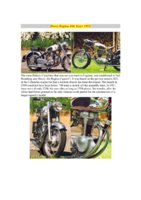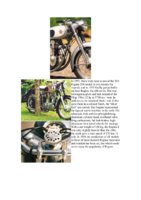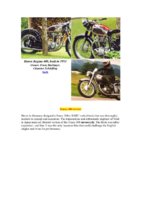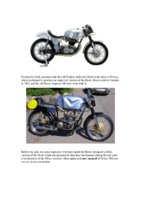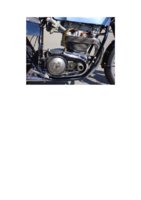The following story was written for the Vintage Japanese Motorcycle Club Journal after some, partly incorrect facts were published about this bike, which is becoming (rightfully) more popular now everywhere. Later-on the Dutch XS650 Club (750 members), published it as well.
“True Story of the Yamaha XS650 series”
In Europe the first model seen in some quantity was the XS1F. The Netherlands received the first batch in May 1971. Prior to this a few of the now famous green XS1’s were shipped to Holland, Germany, Switzerland and Austria, for evaluation purposes.
The information hereunder was compiled for me by my Japanese colleague and friend "Dottore" S. Iwasa, who was chassis development engineer for the Toyota cars mentioned later on and who started working for Yamaha in 1959. An old friend of his in Japan sent us the information.
XS650 (XS1)
1) Summary of production.
The XS650, the largest 4-stroke motorcycle ever made by Yamaha, was launched during the Tokyo Motorshow in October 1969 and was commercialised in March 1970. Production ceased in the spring of 1980, bringing the total production to nearly 300.000 units.
2) Specification
Engine 4-stroke, OHC, Parallel twin, displacement 653 ccm. Transmission 5 speed gearbox, chain final drive. Etc.
3) Objective of the development
The 650 XS1 was the first 4 stroke engine motorcycle ever developed by Yamaha and also the first large displacement engine. Prior to this one the largest engine was the YR-1 Yamaha 2-stroke twin.
In 1965 Honda launched the CB450, which created the gateway to the big motorcycle category for the Japanese manufacturers.
In the U.S. market, where pollution problems were already under discussion, a cleaner motorcycle was preferred and on the other hand 2-stroke motorcycles trailing blue smoke were not getting well accepted.
But more important was that market surveys showed an increasing trend towards bigger motorcycles. The target for Yamaha therefore was clear:
* Light weight and high performance
* Easy handling at level of Yamaha's 350 cc
* For future high engine output SOHC will be better than OHV
* Transferring technology of Toyota 2000 GT engine (designed by Yamaha) to this motorcycle engine
4) Project team
First Engineering group: General Manager Mr. Daisuke Tanaka, Mr. K. Morinaga (who later became the originator of the 5-valve system , Deltabox and other technology of the mid 80's Yamaha's and who sadly passed away) and Mr. H. Sakuma.
Engine development: Chief S. Izumizawa, K. Igarashi, M. Arai.
Chassis development: Chief Y. Hironaka, M. Nakano.
Testing: K. Tuchiya, K. Yamaji
5) Process of the development
At the early stage also a 650 cc 2 stroke twin was considered next to the 4 stroke twin. But the 2 stroke was banned because of the unfavourable exhaust note. The project was officially commenced in August 1967.
The first pre-prototype was a 650 cc engine installed in the R1 (350 cc) chassis and as target bike "Triumph" was chosen from between Triumph, BSA and Norton for further styling reference.
Therefore the feeling of maneuverability and easy handling were developed based upon Triumph. The first prototype was built during the Spring of 1968. Until the end of 1969 a 2nd, 3rd, 4th and 5th prototype were built and 2.500 design modifications sheets were issued!
In the Autumn of 1969 most of the technical problems were solved and the machine was ready for production.
6) Development on the technical side
The basic dimensions for the bore + stroke were taken directly from the Toyota 2000 GT sportscar (75x75x6=1998 cc), which was designed and developed by Yamaha on the request of Toyota Motor Co. The stroke was just shortened by 1 mm, giving 75x74x2=654 cc.
The design of the valve train was the first experience for Yamaha motorcycle engineers, therefore the technology was transferred from the Automobile Division in Yamaha. Although the cam arrangement was changed from DOHC (2000GT) to SOHC, the diameter of the valves, valve angle, valve stem dimension were taken over completely. For example the valve retainer is the same part as on the 2000GT.
(Note: If you are travelling in the Netherlands you can visit the Nationaal Automobile Museum in Raamsdonksveer (near 'Breda), which is owned by the Dutch Toyota Importer, and you can see the only 2000GT's in Europe and furthermore the Toyota "7" racing car, which was totally developed by Yamaha, and which has world's first twin turbo charged 5 litre V-8 racing engine).
The difference between the automobile engine and the motorcycle engine was the rpm at max. power, so some parts had to be changed to tougher material and also finally the valve lift was changed from 6.5 mm to 8.0 mm for higher output. The cam profile of the 2000GT was calculated in and by Toyota, so Yamaha could not use it. Yamaha developed their own calculation system for these polydyne cams.
Please consider that at that time Yamaha did not have a computer, so the IBM computer from Yamaha Musical Instruments Co. was used during the night!
As for the camshaft Yamaha had no experience with a one piece crankshaft for a 4 stroke engine therefore the same press-fit crankshaft type with identical cylinder pitch as for the YR-1 was used. But a 360 degree crank instead of the 180 degree one was used because of vibration. And where the YR-1 had a labyrinth seal between the the left and right crank, the XS carries the sprocket for the SOHC.
The crankcase were designed also horizontal-split with cast-iron inserts for the bearings, 3 roller and a ball-bearing on the right hand side. Lubrication system was wet sump type. Because of the deep crankcases, only the clutch was dipped in the oil. So the function was similar to dry sump.
The pistons were simply 2000GT pistons made of Lo-Ex material. At the beginning the cylinder head had very compact cooling fins, but these grew during development.
The transmission parts layout was taken from the YR-1, like clutch, gears, etc. As for the performance, the prototype engine gave only 20 HP. By re-working the cams by hand during the following months we got 42 HP. Finally we reached 53 HP. Oil leakage was the biggest problem in the early stages of the development, but this was fortunately cured later.
P.S. I do hope it is clear now that the anchester of the XS1 is not the Horex, (even Mr. S. Honda looked more to NSU than to Horex), but a combination of James Bonds' Toyota 2000 GT and Yamaha's own YR-1! Also Hosk did not appear at all in the scenario as some people did think.
Ludy E. Beumer, Copyright
Yamaha Motor Europe N.V.
~kop
“True Story of the Yamaha XS650 series”
In Europe the first model seen in some quantity was the XS1F. The Netherlands received the first batch in May 1971. Prior to this a few of the now famous green XS1’s were shipped to Holland, Germany, Switzerland and Austria, for evaluation purposes.
The information hereunder was compiled for me by my Japanese colleague and friend "Dottore" S. Iwasa, who was chassis development engineer for the Toyota cars mentioned later on and who started working for Yamaha in 1959. An old friend of his in Japan sent us the information.
XS650 (XS1)
1) Summary of production.
The XS650, the largest 4-stroke motorcycle ever made by Yamaha, was launched during the Tokyo Motorshow in October 1969 and was commercialised in March 1970. Production ceased in the spring of 1980, bringing the total production to nearly 300.000 units.
2) Specification
Engine 4-stroke, OHC, Parallel twin, displacement 653 ccm. Transmission 5 speed gearbox, chain final drive. Etc.
3) Objective of the development
The 650 XS1 was the first 4 stroke engine motorcycle ever developed by Yamaha and also the first large displacement engine. Prior to this one the largest engine was the YR-1 Yamaha 2-stroke twin.
In 1965 Honda launched the CB450, which created the gateway to the big motorcycle category for the Japanese manufacturers.
In the U.S. market, where pollution problems were already under discussion, a cleaner motorcycle was preferred and on the other hand 2-stroke motorcycles trailing blue smoke were not getting well accepted.
But more important was that market surveys showed an increasing trend towards bigger motorcycles. The target for Yamaha therefore was clear:
* Light weight and high performance
* Easy handling at level of Yamaha's 350 cc
* For future high engine output SOHC will be better than OHV
* Transferring technology of Toyota 2000 GT engine (designed by Yamaha) to this motorcycle engine
4) Project team
First Engineering group: General Manager Mr. Daisuke Tanaka, Mr. K. Morinaga (who later became the originator of the 5-valve system , Deltabox and other technology of the mid 80's Yamaha's and who sadly passed away) and Mr. H. Sakuma.
Engine development: Chief S. Izumizawa, K. Igarashi, M. Arai.
Chassis development: Chief Y. Hironaka, M. Nakano.
Testing: K. Tuchiya, K. Yamaji
5) Process of the development
At the early stage also a 650 cc 2 stroke twin was considered next to the 4 stroke twin. But the 2 stroke was banned because of the unfavourable exhaust note. The project was officially commenced in August 1967.
The first pre-prototype was a 650 cc engine installed in the R1 (350 cc) chassis and as target bike "Triumph" was chosen from between Triumph, BSA and Norton for further styling reference.
Therefore the feeling of maneuverability and easy handling were developed based upon Triumph. The first prototype was built during the Spring of 1968. Until the end of 1969 a 2nd, 3rd, 4th and 5th prototype were built and 2.500 design modifications sheets were issued!
In the Autumn of 1969 most of the technical problems were solved and the machine was ready for production.
6) Development on the technical side
The basic dimensions for the bore + stroke were taken directly from the Toyota 2000 GT sportscar (75x75x6=1998 cc), which was designed and developed by Yamaha on the request of Toyota Motor Co. The stroke was just shortened by 1 mm, giving 75x74x2=654 cc.
The design of the valve train was the first experience for Yamaha motorcycle engineers, therefore the technology was transferred from the Automobile Division in Yamaha. Although the cam arrangement was changed from DOHC (2000GT) to SOHC, the diameter of the valves, valve angle, valve stem dimension were taken over completely. For example the valve retainer is the same part as on the 2000GT.
(Note: If you are travelling in the Netherlands you can visit the Nationaal Automobile Museum in Raamsdonksveer (near 'Breda), which is owned by the Dutch Toyota Importer, and you can see the only 2000GT's in Europe and furthermore the Toyota "7" racing car, which was totally developed by Yamaha, and which has world's first twin turbo charged 5 litre V-8 racing engine).
The difference between the automobile engine and the motorcycle engine was the rpm at max. power, so some parts had to be changed to tougher material and also finally the valve lift was changed from 6.5 mm to 8.0 mm for higher output. The cam profile of the 2000GT was calculated in and by Toyota, so Yamaha could not use it. Yamaha developed their own calculation system for these polydyne cams.
Please consider that at that time Yamaha did not have a computer, so the IBM computer from Yamaha Musical Instruments Co. was used during the night!
As for the camshaft Yamaha had no experience with a one piece crankshaft for a 4 stroke engine therefore the same press-fit crankshaft type with identical cylinder pitch as for the YR-1 was used. But a 360 degree crank instead of the 180 degree one was used because of vibration. And where the YR-1 had a labyrinth seal between the the left and right crank, the XS carries the sprocket for the SOHC.
The crankcase were designed also horizontal-split with cast-iron inserts for the bearings, 3 roller and a ball-bearing on the right hand side. Lubrication system was wet sump type. Because of the deep crankcases, only the clutch was dipped in the oil. So the function was similar to dry sump.
The pistons were simply 2000GT pistons made of Lo-Ex material. At the beginning the cylinder head had very compact cooling fins, but these grew during development.
The transmission parts layout was taken from the YR-1, like clutch, gears, etc. As for the performance, the prototype engine gave only 20 HP. By re-working the cams by hand during the following months we got 42 HP. Finally we reached 53 HP. Oil leakage was the biggest problem in the early stages of the development, but this was fortunately cured later.
P.S. I do hope it is clear now that the anchester of the XS1 is not the Horex, (even Mr. S. Honda looked more to NSU than to Horex), but a combination of James Bonds' Toyota 2000 GT and Yamaha's own YR-1! Also Hosk did not appear at all in the scenario as some people did think.
Ludy E. Beumer, Copyright
Yamaha Motor Europe N.V.
~kop


